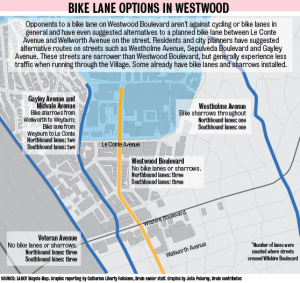Ignorance is bliss – it’s also unsafe, irresponsible and completely inappropriate when forming transportation policy in Los Angeles.
Between 2002 and 2013, there have been 52 bicycle accidents on the stretch of Westwood Boulevard where Los Angeles City Councilmember Paul Koretz, with pressure from some of his constituents, has been opposing the development of a bicycle lane.
UCLA students know the daily commute in Westwood too well. For students who live south of Wilshire Boulevard, biking to campus is perilous because of the lack of bicycle lanes, which encourage drivers to look over their shoulders before making a right turn.
However, some Westwood residents, who have been the most vocal to Koretz, want a different location for the bike lane planned on Westwood Boulevard, such as Sepulveda Boulevard or Gayley Avenue. What these residents need to understand is that Westwood Boulevard is far safer than other options because of slower vehicle speeds. The greater amount of stoplights and pedestrian traffic on Westwood Boulevard causes much slower speeds among drivers, leading to safer cycling conditions.
However, Koretz abandoned an engineering study on potential bike lanes on Westwood Boulevard before it determined whether a bike lane would hinder traffic. In an email to some of his constituents Nov. 11, 2013, Koretz said, “I can’t see any way that I wind up supporting the bike lane on Westwood (Boulevard) anyway, I am just going to kill it now, rather than waiting for a study.”
Koretz should give the bike lane on Westwood Boulevard a chance by letting the engineering study proceed instead of proposing an amendment to remove it from the Los Angeles Mobility Plan 2035.
Without bike lanes, drivers feel less obligated to share the road and often forget that cyclists are on the roadways too. Drivers conduct themselves in a much safer manner around bike lanes, which give them a constant reminder to check over their shoulder before merging into the right turn lane.
Similar plans have worked in other cities. In 2011, New York City developed a protected bike lane on Columbus Avenue, an extremely busy street in Manhattan. Consequently, crashes between cars and bikes decreased 34 percent and cycling on weekdays increased 56 percent.
In addition, a memorandum from the New York City mayor’s office in 2011 stated that when protected bike lanes were installed in the city, injury crashes dropped by 40 percent to more than 50 percent for all road users .
Similarly, when a protected bike lane was installed in Washington, D.C., only 26 percent of drivers exceeded the speed limit as opposed to 66 percent before the lane.
In addition to improving cyclists’ safety, the bike lane would increase retail revenues in Westwood Village’s businesses.
This too has precedence elsewhere. In Salt Lake City’s Broadway area, retail sales increased by 8.8 percent after a bike lane was built.
The increase in business revenue could actually be significantly greater than in Salt Lake City because of Westwood’s significant population of students without cars. The bike lane would encourage students to frequent Westwood because of the safer cycling conditions.
The Westwood Village Improvement Association’s executive director, Andrew Thomas, said the same uptick in business will happen in Westwood if bike lanes are installed on Westwood Boulevard. He added that an engineering study is the only way to see the true impacts of a bike lane.
Nonetheless, Koretz continues to block the study, which would determine the impact of bike lanes on Westwood Boulevard.
Paul Neuman, Koretz’s spokesperson, said in an email statement we should discourage cyclists from riding this stretch of Westwood Boulevard and that “placing lines on a street in the name of increased safety doesn’t necessarily lower the accident rate.”
However, Koretz has no factual information about bicycle lanes hurting the community, while previous cities’ studies show bicycle lanes only help cyclists’ safety and businesses. Without the engineering study’s completion, Koretz has no reason to oppose the bike lane.
In fact, according to the Los Angeles County Bike Coalition, the preliminary study Koretz cancelled was leaning towards declaring the possibility of installing a bike lane without removing any traffic lanes or parking.
If the study had been allowed to reach this conclusion, it would have proven that the impact on drivers and bus timetables would be negligible, but Koretz did not allow the city to finish the study and instead lacks transparent evidence about the lane for his constituents.
Rather than encouraging residents to bike more often, Koretz is prioritizing drivers over cyclists’ safety on Westwood Boulevard. Instead of serving the whole of his constituency, he’s avoiding learning more about how bike lanes could help or hurt the community.
Koretz needs to let the engineering study proceed before trying to block the bike lane’s passage without any sound evidence.

